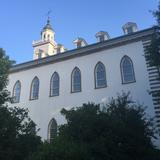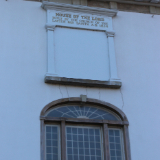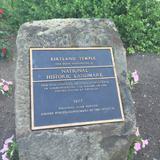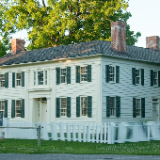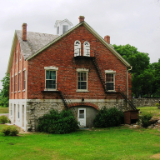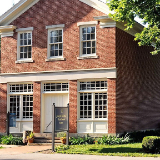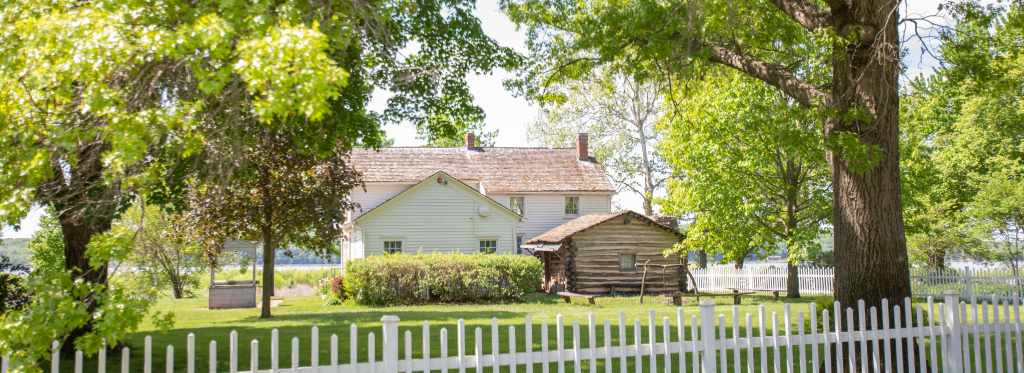
News Release
Frequently Asked Questions Clarify the Transfer of Sacred Sites and Historic Documents
(See Appendix below for a list of items transferred!)
1. What was included in the transaction? The transaction involves land, buildings, artifacts, and documents. The real estate, along with some artifacts, are in Kirtland, Ohio, and Nauvoo, Illinois, while artifacts and documents also come from Community of Christ Library and Archives in Independence, Missouri.
2. What are the most significant items? The most significant properties are the Kirtland Temple, the Smith Family Homestead, the Mansion House, the Nauvoo House, and the Red Brick Store. Significant documents and artifacts include manuscripts and the Bible used in the Joseph Smith Translation of the Bible, seven letters from Joseph Smith to his wife Emma, John Whitmer’s history of the Church, original portraits of Joseph and Emma Smith, the cornerstone of the Nauvoo House, the original door of Liberty Jail, and a document with the title of “Caractors,” which may contain a sample of inscriptions from the gold plates. (See the appendix for a more detailed list of items transferred.)
3. How did Community of Christ acquire these materials?
After the Saints left Kirtland in the 1830s, different parties controlled access to the temple over the years. In 1901, Community of Christ, then known as the Reorganized Church of Jesus Christ of Latter Day Saints (“RLDS Church”) secured title to the Kirtland Temple through legal proceedings. The Smith family properties in Nauvoo remained in possession of Emma Smith after Joseph Smith’s death and she and her children eventually joined the RLDS Church. Thereafter, the properties passed through family connections to the RLDS Church. Other documents and artifacts were donated to the RLDS Church archives by their individual owners.
4. Why did Community of Christ sell these materials now?
As Community of Christ President Stephen M. Veazey noted in the joint statement, the transfer of materials at this time enables their mission and priorities around the world.
5. Why did The Church of Jesus Christ of Latter-day Saints purchase these materials?|
The sites and artifacts in this transaction relate to significant events and people in the Restoration of the gospel of Jesus Christ.
6. What is the relationship between the two churches?
The two churches enjoy a strong, respectful, and friendly relationship. For many decades, we have collaborated on numerous historical and humanitarian projects.
7. Have there been previous transactions of historic materials between the two churches?
Yes. In 2012, Community of Christ sold to the Church of Jesus Christ several properties, including the Hawn’s Mill Massacre site and the Joseph and Emma Smith home in Kirtland. Five years later, Community of Christ sold the Printer’s Manuscript of the Book of Mormon to the Church of Jesus Christ.
8. What was paid for the properties, artifacts, and documents?
The Church paid US$192.5 million without assigning specific values to the properties and items.
9. Will the historic sites be open to the public?
Yes. The historic buildings in Kirtland and Nauvoo closed on March 5, 2024, to facilitate the transfer of ownership and will reopen to the public on March 25, 2024. Tours will be provided of the Kirtland Temple, the Smith Family Homestead, the Mansion House, and the Red Brick Store. Updated visitor information will be published on the historic site webpages for Historic Kirtland and Historic Nauvoo.
10. Will admission be charged to visit the sites?
No. All of the Church of Jesus Christ’s historic sites are open to the public at no charge.
11. Will members of Community of Christ continue to have access to the sites?
Yes. The sites will be open to the public generally. The Church has also made specific arrangements with Community of Christ to allow for special meetings and gatherings over the coming years.
12. Will the Kirtland Temple be converted into a functioning Latter-day Saint temple?
No. The Kirtland Temple will be maintained and presented as a historic building that is open to the public. President Russell M. Nelson announced a temple in Cleveland in April 2022, and the Church released its site address in December 2022 and a rendering in July 2023.
13. Will the Church continue to pursue development of its proposed new visitors’ center near the Nauvoo Temple?
Yes. The proposed visitors’ center in Nauvoo will orient visitors to the historic and contemporary significance of the Nauvoo Temple. The use of the other two visitors’ centers in Nauvoo will be determined in the future.
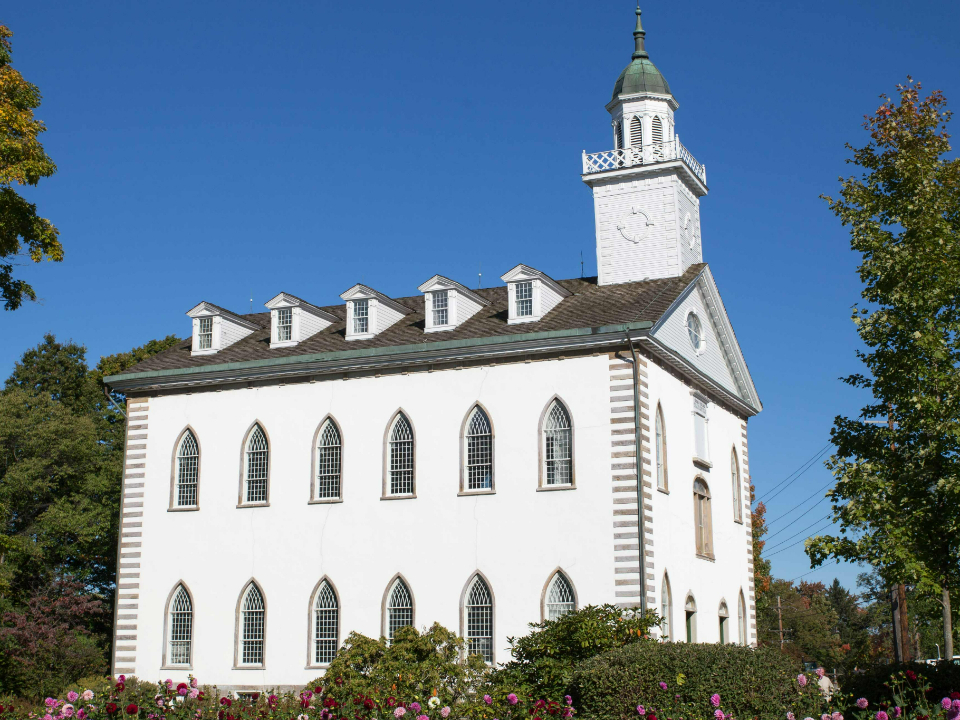
| The Kirtland Temple was the first temple built by the Saints in the latter days. 2024 by Intellectual Reserve, Inc. All rights reserved. |
Appendix: List of Items Transferred
Historic Buildings that Will Remain Open to the Public in Kirtland, Ohio: Kirtland Temple, 9020 Chillicothe Road
Historic Buildings that Will Remain Open to the Public in Nauvoo, Illinois: Smith Family Homestead and Summer Kitchen, 935 South Main Street
Joseph and Emma Smith Mansion House, 890 South Main Street
Red Brick Store (reconstructed), 610 Water Street
Nauvoo House, 950 South Main Street
Historical Artifacts:
Portraits of Joseph and Emma Smith, circa 1842, attributed to David Rogers
Original door of Liberty Jail, circa 1833
Book of Mormon “Caractors” document
Four pages from Revelation Book 1, including portions of revelations now known as Doctrine and Covenants 64, 65, 66, 76, 81, and 133
Seven letters from Joseph to Emma Smith, including letters written on 13 October 1832, 18 May 1834, 4 November 1838, 12 November 1838, 9 November 1839, 23 June 1844, and 27 June 1844
A history of the church, written by John Whitmer
Manuscript notes of 1879 interview with Emma Smith by Joseph Smith III
Joseph Smith’s printed “Phinney” Bible (Cooperstown, New York, 1828) with his numerous markings as part of the Joseph Smith Translation of the Bible
Manuscripts of the Joseph Smith Translation of the Bible:
Old Testament manuscript 1 (June 1830–7 March 1831)
Old Testament manuscript 2, first part (8 March–5 April 1831)
Old Testament manuscript 2, second part (20 July 1832–2 July 1833)
Old Testament manuscript 3 (ca. late 1830–early 1831)
New Testament manuscript 1 (8 March–June 1831)
New Testament manuscript 2, Folio 1 (4 Apr 1831–26 Sep 1831)
New Testament manuscript 2, Folio 2 (26 Sep 1831–late 1831)
New Testament manuscript 2, Folio 3 (winter 1831–1832)
New Testament manuscript 2, Folio 4 (January/February 1832–31 July 1832)
Publication committee manuscripts for the first complete edition of the Joseph Smith Translation of the Bible as The Holy Scriptures (1867)
Joseph Smith writing desk (Kirtland Temple)
1820s couch associated with the Whitney family (Kirtland Temple)
Original elements of the Kirtland temple:
Oval window frame
Front door keystone and frame
Stone arch
Windows
Pieces of original stucco and sandstone
Nauvoo Temple Sunstone
Two Nauvoo Temple Moonstones
Nauvoo House cornerstone, which housed the Original Manuscript of the Book of Mormon
Joseph Smith desk (Mansion House)
Emma Smith trunk (Mansion House)
Lucy Mack Smith rocking chair (Mansion House)
Two Smith family chairs (Mansion House)
Emma Smith walking stick (Homestead)
Washstand associated with Hawn’s Mill (Homestead)
Sampler (Homestead)
Bowl (Homestead)
Three inkwells (Red Brick Store)
In addition, the transfer includes the vast majority of representative period artifacts that are currently on display in the historic buildings (most of these artifacts are not historically associated with the Smith family or with Nauvoo).
Non-Historic Buildings in Kirtland
Temple Visitor’s Center, 9076 Chillicothe Road
Private residence and shop, 7788 Maple Street
Private residence, 7799 Joseph Street
Private residence, 9120 Timothy Lane
Small Undeveloped Lots in Kirtland
[unnumbered] Joseph Street
9080 Chillicothe Road
Historic Buildings with Modernized Interiors in Nauvoo (Private Use)
Hiram and Thankful Clark home, 790 South Hyde Street
Aaron and Polly Johnson home, 475 Water Street
William and Rosannah Marks home, 575 Water Street
Sidney and Phebe Rigdon home, 860 South Main Street
Jonathan and Rebecca Wright home, 455 Water Street
The First Hotel, 795 South Main Street
A stone stable built by Lewis Bidamon, 940 South Main Street
Non-Historic Buildings in Nauvoo
Maintenance Shop, Bain Street
All Nauvoo Blocks and Lots (indexed to the 1842 Map of the City of Nauvoo)
Block 137, Lot 4 – no structures
Block 138 – no structures
Block 139, lots 3-4 – includes the First Hotel
Block 140, lots 3-4 – no structures
Block 145 – no structures
Block 146 – includes the Joseph Smith Historic Site Visitor’s Center (initially leased by the Church and subject to a secondary closing at a later date), James and Sally Brinkerhoff former home site, and Levi and Clarissa Hancock former home site
Block 147 – includes the Mansion House, Rigdon home, Clark home, Samuel and Levira Smith former home site, and Theodore and Frances Turley former home site
Block 148 – includes the William Law store former site
Block 149 – includes the Marks home, public restrooms, a Hyrum Smith office former site, and the Times and Seasons newspaper office former site
Block 150 – includes the Johnson home, Wright home, maintenance shop
Block 153 – no structures
Block 154 – includes a Hyrum Smith office former site
Block 155 – includes the Red Brick Store and the Smith Homestead and summer kitchen; does not include the Smith Family Cemetery
Block 156 – includes the Nauvoo House, Bidamon stable, Joseph Smith red brick stable former home site, Joseph Sr. and Lucy Smith former home site, Porter Rockwell former home site, and a parking area
Block 157 – no structures
Block 158, lots 2-3 – includes private residence (960 South Partridge Street)
Block 161 – no structures
Block 162 – no structures


